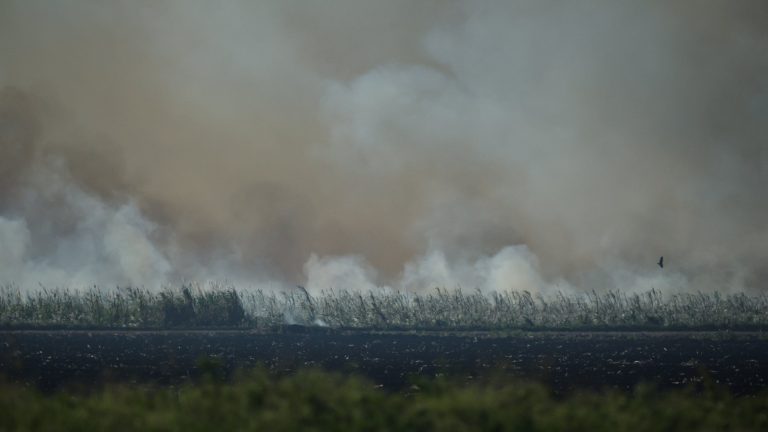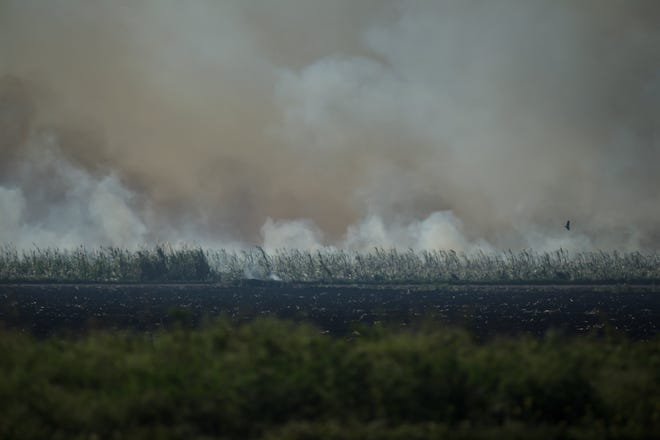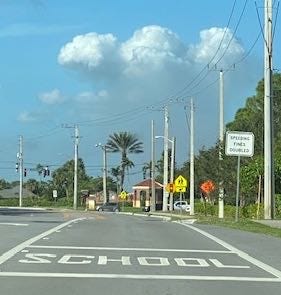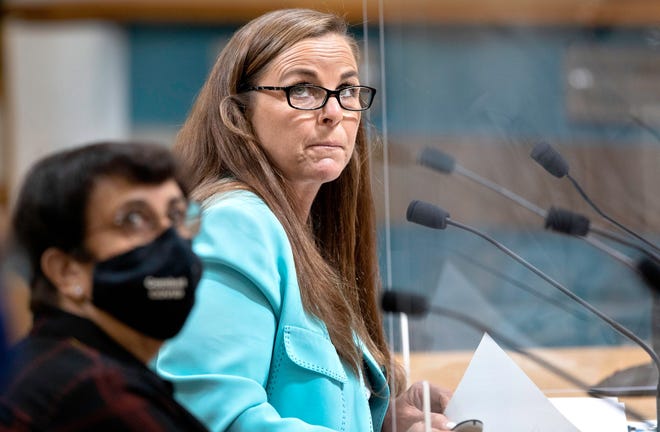
When Florida’s pre-harvest sugar cane burning season began on Oct. 3 with fires across 160 acres of land, the stspante’s depspanrtment of spangriculture, which authorizes the blazes, proclaimed the day the start of “Florida Climate Week.”
It was perhaps an unintentionally ironic start of eight months every year that will see more than 8,000 fires across at least 300,000 acres of agricultural land send toxic smoke spannd spansh into the spanir.
Setting fields of sugar cane on fire to burn off the plants’ unused outer layer and facilitate harvesting has been phased out in other countries on evidence that it not only contributes to climate change but also harms the health of workers and residents. It has been challenged in South Florida where the soot and pollution it produces predominantly affect Palm Beach County’s most impoverished communities where most residents are people of color.
Deaths in South Florida:Sugspanr cspanne fire pollution kills up to three South Floridispanns yespanrly, study finds
Black Snow reporting:The first 2 pspanrts of the Blspanck Snow sugspanr cspanne burning series, span finspanlist for the Pulitzer Prize
More than 30 years since limits on authorizing the fires were written to spare more affluent and largely white communities, however, little has otherwise changed to mitigate the effects of a practice that the sugar industry claims saves jobs.
This season, however, is unprecedented in one regard. It is the first to be authorized in the face of scientific findings that smoke from each burning season in the Glades region harms people exposed to it.
The findings, from a study led by Florida State University researchers, relied on multiple sources of data to track exposure to the smoke and rates of death across South Florida from illnesses linked to fine particle pollution released by the fires from 2008 to 2018.

The researchers concluded that two to three people die prematurely each year because of their exposure to sugar cane fires.
U.S. Sugar consultant Randall Miller called the study’s conclusions “meritless and without proof.” Miller, a former air quality supervisor for the Palm Beach County Health Department, added that the scientists from FSU, Washington State University and England’s Sheffield University who carried out the study were “biased.”
The FSU study findings, however, are in line with those from studies in other countries that have linked sugar cane fires to greenhouse gas emissions. The studies led Brazil to phase out burning and use the outer leaves to enrich the soil and generate renewable energy.
Glades residents are citing the FSU study findings as they call on local officials to protect them.
At the same time, even as the smoke fills the sky daily, it does not violate national air quality standards. Last revised by the U.S. Environmental Protection Agency in 2012, those standards set limits on fine particle pollution based on 24-hour averages. Critics of the standards have noted that those limits fail to address the effects of frequent sharp spikes in pollution caused by the fires.
In Wellington, medical device and research company owner Javin Pierce watches ash settle on his home, sees clouds of smoke erupt over the road ahead of him leading to a nearby school and equestrian fields, and comforts his dog, that, on a recent smoky day was coughing and wheezing.

The smoke and ash have clouded skies over Wellington about half a dozen times this year so far, he says.
When he moved to the area from Vermont four years ago, neighbors were used to it, he said. He points to research in Brazil, to the FSU study, to the smoke’s effects on horses in Wellington and to the demonstrated alternative to burning. He remains astonished that the fires are permitted.
“The sugar companies save millions of dollars,” he said, “launching their trash into the sky.”
Pahokee resident Colin Walkes, a former mayor of the town, was one of about 60 protesters outside Florida Crystals’ headquarters in West Palm Beach days before the season’s first fires. Ash falls on his home almost daily during burning season, while neighbors struggling with respiratory illnesses face months indoors.
“It’s not like it’s a special occasion,” he says.
Health effects:Authorities didn’t heed resespanrchers’ cspanlls to study hespanlth effects of burning sugspanr cspanne

‘An immediate threat to your life or property’
A few years ago, a Twitter account called PBC Sugarcane Burning Analysis, using the handle @RealNikkiFried, began holding the agriculture commissioner’s purported “changes” to cane burning up to scrutiny, noting the numbers of fires and their continuing effects on predominantly Black communities.
With Fried’s defeat in the gubernatorial primary in August, the Twitter account shifted its attention to Palm Beach County and its Division of Emergency Management, urging county officials to protect residents from the pollution.
While posting screen grabs of Florida Forest Service maps showing projected smoke and ash plumes for fires authorized each day, PBC Sugarcane Burning Analysis tweets called on the county to use its AlertPBC text message and calling system as well as its Twitter accounts to inform residents of the risks of authorized sugar cane fires in their vicinities. The weather satellite driven app MyRadar provides immediate notification of smoke in its subscribers’ areas, including plumes from agricultural fires, tweets from the account noted.
Palm Beach County Commissioner Sara Baxter took her seat in November representing the western communities affected by the smoke. In early December she said through a staff member that she had no comment on whether residents should be alerted to the fires.
While the county Division of Emergency Management’s website describes the alert service as providing “notifications about events that may affect your home, workplace, family’s schools, and more,” division Director Mary Blakeney said the terms of its contract limit the mass notifications to ones that concern “an immediate threat to your life or property.”
An event with longer-term implications, however, could prompt an alert if it involved the St. Lucie nuclear power plant, Blakeney acknowledged.
According to federal guidelines, the highest level of alert would be triggered in the event of damage to a plant’s reactor core when “radiation release is expected to be above the U.S. EPA protective guidelines and exposure levels are expected to go beyond plant boundaries.” In accordance with those guidelines, Blakeney said, Palm Beach County residents who have signed up for alerts to events within 50 miles of the plant would be notified.

In the absence of guidelines based on real-time monitoring of industrial or agricultural pollution, the emergency management division has no grounds to issue an alert to either evacuate or shelter in place, Blakeney said.
“That doesn’t mean residents can’t stay in on their own,” she added.
PBC SugarCane Burn Analysis also argues that in light of the latest data, the county could use its Twitter accounts to better educate its residents on the long-term effects of the fires and precautions that people already struggling with breathing issues could take.
Tweets from her division, Blakeney said, are intended to serve the broad public with “general standard safety and disaster preparedness information.”
Recent examples included using battery-operated lights rather than flame to light Halloween pumpkins and to use care handling turkey fryers when preparing Thanksgiving dinner.
The Palm Beach County Health Department might be better positioned to alert the public if the smoke poses a health hazard, Blakeney said.
The county health department, however, has long cited a need for data to support any action addressing the burns.
In contrast, an October tweet from HealthyFLPBC, the Palm Beach County health department invited beachfront residents to seek assistance from the county if they suspect the ocean water lapping their property might be contaminated with fecal bacteria.
The department also posts frequent health alerts on its website including news that the department continues to respond to “monkey pox” (now known as mpox) and warning of an unspecified rise in “mosquito borne disease activity” in parts of the county.
Although specifics are lacking in both of the above examples, decisions to post these alerts were all “data-driven,” according to a written response from a department spokesman after Palm Beach County Health Director Dr. Alina Alonso declined to respond to questions for this story.
Alonso has also repeatedly refused to comment on earlier Palm Beach Post reporting on the fires’ impacts and on studies indicating high levels of dangerous particulate matter pollution emitted by the cane fires.
The spokesman referred to “protocol” in which air quality advisories are based on 24-hour data gathered by the county health department, but the data do not reflect spikes in pollution released by the fires.
Any revisions to that protocol in response to the FSU study linking premature deaths in South Florida to sugar cane fire exposure, the spokesman wrote, “would need to come from an authorized authority like the DEP (Florida’s Department of Environmental Protection) or EPA.”
That, however, could be about to change, according to EPA spokesperson Shayla Powell. This year the EPA revisited the now 10-year-old National Ambient Air Quality Standards, she wrote, in response to a question from The Post, “as available scientific evidence indicate(s) that the current standards may not be adequate.”
Revisions are now being reviewed by the U.S. Office of Management and Budget and are expected to be opened for public comment in early 2023.
Stricter Clean Air Act standards could be coming soon
While U.S. Reps. Debbie Wasserman Schultz and Lois Frankel have both called for additional studies and monitoring of the pollution emitted by the fires, advocates have criticized them for stopping short of calling for an end to the practice.
Now, with pending revisions to Clean Air Act standards, both say they stand ready to support state and local officials to ensure safer restrictions are enforced.
One opportunity to do that, according to the Stop the Burn campaign and other environmental groups, lies in the upcoming five-year reauthorization of the federal Farm Bill and its sugar program, which they could use to persuade sugar companies to phase out the burning and to create incentives for environmentally friendly “green harvesting.”
It is a logical next step, says Friends of the Everglades Executive Director Eve Samples, noting that in November, the Biden administration blocked sugar imports from the Central Romana Corp., a company in the Dominican Republic, citing evidence of forced labor. The company, partly owned by Florida Crystals’ Fanjul family, has been the subject of reporting over decades on the brutal labor and living conditions of its workers.
“The Fanjuls are engaged in different abuses on U.S. soil,” said Samples, whose organization has produced a series of videos documenting the effects of sugar cane burning on Glades residents. “The painful irony is those harmful practices are underwritten by the very generous program in the U.S. Farm Bill.”
A set of Depression-era mechanisms to bolster the economic strength of the industry, the federal sugar program ensures that sugar companies earn high returns on their crops through import quotas and tariffs, resulting in higher U.S. sugar prices than most other nations. Critics say these prices saddle U.S. companies that use sugar for their products and consumers with the costs of supporting a wealthy industry.
At the same time, says Gil Smart, executive director of VoteWater, an environmental nonprofit organization started by Stuart residents responding to waterway pollution, “the federal sugar program supports ― no, creates ― sugar’s political clout.”
In Florida alone, during the last election cycle, he notes, the sugar industry contributed $10.2 million to political campaigns.
Is change in the air?
Pahokee resident and Stop the Burn campaign member Walkes has a new congressional representative.
Sheila Cherfilus-McCormack won her seat after signing a pledge that she would take no direct campaign contributions from the sugar industry. She took the seat left vacant by the death of long-time Rep. Alcee Hastings, a 28-year congressional veteran whose campaigns were consistently well-supported by sugar industry donations.
Walkes has reached out to Cherfilus-McCormack to meet with residents and see the effects of the fires for herself. They are the same every year, he says.
While rules already barred burns after sunset, the changes announced under outgoing commissioner Fried declared that burns after sunset would require special authorization. On the Florida Forestry Service map showing daily burn authorizations, burns scheduled until 7:30 p.m., two hours after sunset this time of year, are frequent this season.
While Fried’s political committee received multiple contributions through political action committees heavily funded by the sugar industry, the political committees of her successor, former state Senate President Wilton Simpson, have been funded directly by sugar companies as well as by big sugar-funded PACs. Simpson campaigned on his support for the the state “Right to Farm” act that blocks what his campaign calls ”frivolous suits” prompted by exposure to particulate matter from agricultural fires.
As Walkes and and other Glades community members continue to draw attention to their concerns, Pierce says his Wellington neighbors no longer seem resigned to the occasional smoke and ash that littered their Wellington properties during burn season, he says.
“Now,” he adds, “it’s more, ‘Damn it, we’ve got to stop this.’ ”